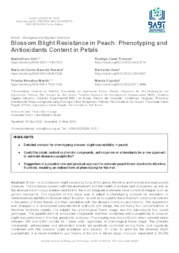Blossom Blight Resistance in Peach: Phenotyping and Antioxidants Content in Petals.
Blossom Blight Resistance in Peach: Phenotyping and Antioxidants Content in Petals.
Author(s): DINI, M.; RASEIRA, M. do C. B.; MARCHI, P. M.; FRANZON, R. C.; UENO, B.; VIZZOTTO, M.
Summary: Brown rot and blossom blight caused by fungi of the genus Monilinia are the most important peach diseases. The increased concern with the environment and the health of workers and consumers, as well as the emergence of fungus isolates resistant to the main fungicide molecules favor control strategies such as genetic resistance. The objective of this study was to adjust a phenotyping protocol for evaluation of resistance/susceptibility to blossom blight in peach, as well as to quantify the antioxidant compounds present in the petals of these flowers and their correlation with the disease incidence and severity. The experiment was arranged in a randomized complete block split-split plot design, the plot being four concentrations of Monilinia fructicola conidia; the subplot two phenological flower stage; and the sub-subplot four peach genotypes. The quantification of antioxidant compounds and their correlation with susceptibility to blossom blight was performed in the four genotypes analyzed. Phenotyping was more efficient when concentrations between 400 and 4,000 conidia mL-1 were used, regardless of phenological flower stage. The phenolic compounds, anthocyanins and antioxidant activity are positively correlated among them, and negatively correlated with the blossom blight incidence and severity. In order to estimate the blossom blight susceptibility, it is recommended to use flowers at the pink or bloom stage, inoculum equivalent to 20-200 conidia per flower, and perform the evaluation at 96 hours after inoculation. This study suggests that more intense pink flowers have a higher content of antioxidant compounds and less blossom blight susceptibility.
Publication year: 2023
Types of publication: Journal article
Keywords: Fenótipo, Monilinia fructicola, Multidisciplinary, Prunus Persica, Pêssego
Observation
Some of Embrapa's publications are published as ePub files. To read them, use or download one of the following free software options to your computer or mobile device. Android: Google Play Books; IOS: iBooks; Windows and Linux: Calibre.
Access other publications
Access the Agricultural Research Database (BDPA) to consult Embrapa's full library collection and records.
Visit Embrapa Bookstore to purchase books and other publications sold by Embrapa.

